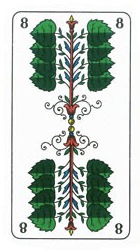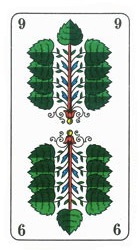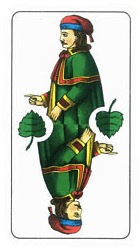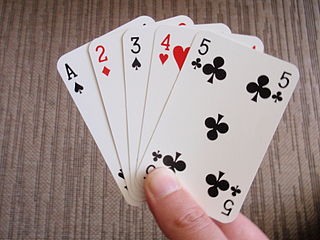
A playing card is a piece of specially prepared card stock, heavy paper, thin cardboard, plastic-coated paper, cotton-paper blend, or thin plastic that is marked with distinguishing motifs. Often the front (face) and back of each card has a finish to make handling easier. They are most commonly used for playing card games, and are also used in magic tricks, cardistry, card throwing, and card houses; cards may also be collected. Playing cards are typically palm-sized for convenient handling, and usually are sold together in a set as a deck of cards or pack of cards.

In playing cards, a suit is one of the categories into which the cards of a deck are divided. Most often, each card bears one of several pips (symbols) showing to which suit it belongs; the suit may alternatively or additionally be indicated by the color printed on the card. The rank for each card is determined by the number of pips on it, except on face cards. Ranking indicates which cards within a suit are better, higher or more valuable than others, whereas there is no order between the suits unless defined in the rules of a specific card game. In a single deck, there is exactly one card of any given rank in any given suit. A deck may include special cards that belong to no suit, often called jokers.

In a deck of playing cards, the term face card (US) or court card, and sometimes Royalty, is generally used to describe a card that depicts a person as opposed to the pip cards. In a standard 52-card pack of the English pattern, these cards are the King, Queen and Jack. The term picture card is also common, but that term sometimes includes the Aces.

The standard 52-card deck of French-suited playing cards is the most common pack of playing cards used today. In English-speaking countries it is the only traditional pack used for playing cards; in many countries of the world, however, it is used alongside other traditional, often older, standard packs with different suit systems such as those with German-, Italian-, Spanish- or Swiss suits. The most common pattern of French-suited cards worldwide and the only one commonly available in English-speaking countries is the English pattern pack. The second most common is the Belgian-Genoese pattern, designed in France, but whose use spread to Spain, Italy, the Ottoman Empire, the Balkans and much of North Africa and the Middle East. In addition to those, there are other major international and regional patterns including standard 52-card packs, for example, in Italy that use Italian-suited cards. In other regions, such as Spain and Switzerland, the traditional standard pack comprises 36, 40 or 48 cards.

Playing cards have been in Italy since the late 14th century. Until the mid 19th century, Italy was composed of many smaller independent states which led to the development of various regional patterns of playing cards; "Italian suited cards" normally only refer to cards originating from northeastern Italy around the former Republic of Venice, which are largely confined to northern Italy, parts of Switzerland, Dalmatia and southern Montenegro. Other parts of Italy traditionally use traditional local variants of Spanish suits, French suits or German suits.

Spades is one of the four playing card suits in the standard French-suited playing cards. It has the same shape as the leaf symbol in German-suited playing cards but its appearance is more akin to that of an upside down black heart with a stalk at its base. It symbolises the pike or halberd, two medieval weapons, but is actually an adaptation of the German suit symbol of Leaves created when French suits were invented around 1480.

Sedma is a Czech 4-card trick-and-draw game played by four players in fixed partnerships with a 32-card Bohemian-pattern pack. Card suits do not play a role in this game, and there is no ranking order. A trick is won by the last player to play a card of the same rank as the card led.
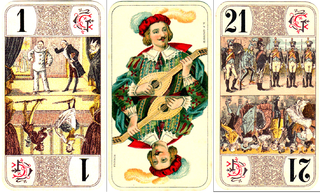
The Bourgeois Tarot deck is a mid-19th century pattern of tarot cards of German origin that is used for playing card games in western Europe and Canada. It is not designed for divinatory purposes. This deck is most commonly found in France, Belgian Wallonia, Swiss Romandy and Canadian Québec for playing French Tarot; in southwest Germany for playing Cego and Dreierles; and in Denmark for Danish Tarok.

German-suited playing cards are a very common style of traditional playing card used in many parts of Central Europe characterised by 32- or 36-card packs with the suits of Acorns, Leaves, Hearts and Bells. The German suit system is one of the oldest, becoming standard around 1450 and, a few decades later, influencing the design of the now international French suit system of Clubs, Spades, Hearts and Diamonds. Today German-suited playing cards are common in south and east Germany, Austria, German-speaking Switzerland, Liechtenstein, north Italy, Hungary, Czech Republic, Slovakia, Slovenia, Croatia, Bosnia, northern Serbia, southern Poland and central and western Romania.

The Ober, formerly Obermann, in Austrian also called the Manderl, is the court card in the German and Swiss styles of playing cards that corresponds in rank to the Queen in French packs. The name Ober is an abbreviation of the former name for these cards, Obermann, which meant something like 'superior' or 'lord'. Van der Linde argues that the King, Ober and Unter in a pack of German cards represented the military ranks of general, officer (Oberofficier) and sergeant (Unterofficier), while the pip cards represented the common soldier.

French-suited playing cards or French-suited cards are cards that use the French suits of trèfles, carreaux, cœurs, and piques. Each suit contains three or four face/court cards. In a standard 52-card deck these are the valet, the dame, and the roi (king). In addition, in Tarot packs, there is a cavalier (cavalier) ranking between the queen and the jack. Aside from these aspects, decks can include a wide variety of regional and national patterns, which often have different deck sizes. In comparison to Spanish, Italian, German, and Swiss playing cards, French cards are the most widespread due to the geopolitical, commercial, and cultural influence of France, the United Kingdom, and the United States in the 19th and 20th centuries. Other reasons for their popularity were the simplicity of the suit insignia, which simplifies mass production, and the popularity of whist and contract bridge. The English pattern of French-suited cards is so widespread that it is also known as the International or Anglo-American pattern.

Hearts is one of the four playing card suits in a deck of French-suited and German-suited playing cards. However, the symbol is slightly different: is used in a French deck while is used in a German deck.

Acorns is one of the four playing card suits in a deck of German-suited and Swiss-suited playing cards. This suit was invented in 15th-century German-speaking lands and is a survivor from a large pool of experimental suit signs created to replace the Latin suits. Around 1480, French card makers adapted this sign into clubs in a French deck.

Bells is one of the four playing card suits in a deck of Swiss-suited and German-suited playing cards. Unlike the other German suits, this suit was not adapted by French card makers. In its place, there was initially a suit of red crescents until the suit of Diamonds was added to the French pack. The suit is usually known in German as Schellen, but is sometimes abbreviated to Schell. Cards are referred to as in a French deck e.g. the "9 of Bells", but in German as Schellen 9, or the "Unter of Bells".

Dreierschnapsen, Talonschnapsen or Staperlschnapsen is a three-hand variant of the popular Austrian card game, Bauernschnapsen. The rules are very similar to those for Bauernschnapsen except that, instead of two teams of two players, one player bids to become the soloist against the other two who form a temporary alliance. Another difference is that the game makes use of a talon with which the soloist may exchange cards to improve his hand, hence its alternative name of Talonschnapsen. The game is usually played with William Tell cards.

Binokel is a card game for two to eight players that originated in Switzerland as Binocle, but spread to the German state of Württemberg, where it is typically played with a Württemberg pattern pack. It is still popular in Württemberg, where it is usually played in groups of three or four as a family game rather than in the pubs. In three-hand games, each player competes for himself, while in four-hand games, known as Cross Binokel (Kreuzbinokel), two teams are formed with partners sitting opposite one another. The game was introduced to America by German immigrants in the first half of the 20th century, where it developed into the similar game of pinochle. Binocle was still played in Switzerland in 1994. In south Germany, the game is sometimes called by its Swabian name, Benoggl.

Grasobern, Grasoberl, Grasoberln, Graseberla, Grünobern, Lauboberl or Laubobern is a card game that was once commonly played in Old Bavaria, especially in the old counties of Bad Aibling and Rosenheim, and is still popular in eastern Bavaria, especially in Upper Palatinate. The game has relatively simple rules and thus a rather relaxing and leisurely character without the mental demands of Schafkopf or psychological stress of Watten, two other traditional Bavarian card games. The name is taken from the game's penalty card, the Ober of Leaves. The suit of Leaves is known in German variously as Laub, Gras ("grass") or Grün ("green").

Rumpel is a card game, that is native to the Danube region from Regensburg to Linz, but is played especially in the region of Hauzenberg in the German county of Passau in Bavaria. Mala describes a version with 8 or 12 contracts from a menu of 29 called Großer Rumpel. It is a descendant of the old Austrian student's game of Quodlibet.

Lorum or Lórum is an old, Hungarian, compendium card game for 4 players. Although it is the ancestor of the French game, Barbu, it is still played today. It uses a German-suited pack of 32 cards and comprises 8 individual contracts, each with different rules, each of which is played four times so that a session consists of a total of 32 individual games and lasts about 1½ hours.

![]() ) (German : Laub) is one of the four playing card suits in a deck of German-suited playing cards. This suit was invented in 15th century Germany and is a survivor from a large pool of experimental suit signs created to replace the Latin suits. Around 1480, French card makers adapted this sign into Spades in the French pack (known as pikes in France). [1]
) (German : Laub) is one of the four playing card suits in a deck of German-suited playing cards. This suit was invented in 15th century Germany and is a survivor from a large pool of experimental suit signs created to replace the Latin suits. Around 1480, French card makers adapted this sign into Spades in the French pack (known as pikes in France). [1] 
